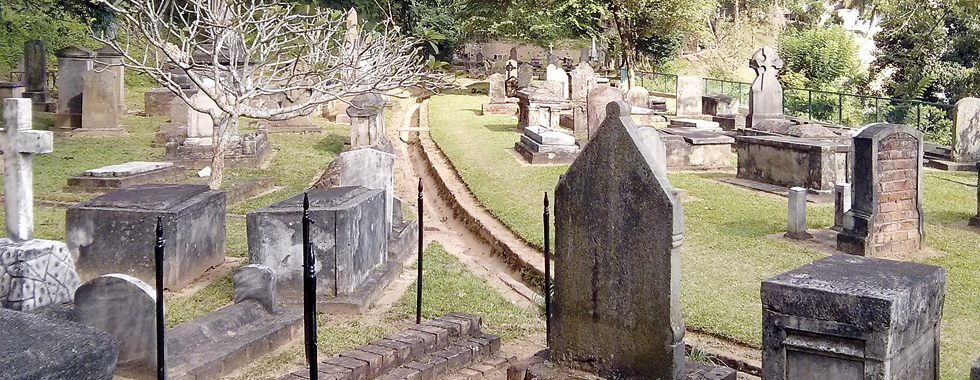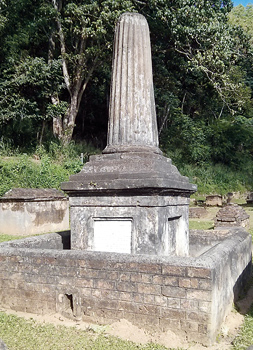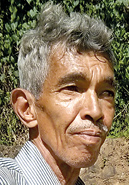Dead men tell no tales, but the caretaker does
On the north end of the Bogambara lake is the hot-bed of Kandyan history. The Sri Dalada Maligawa, the old Courts Complex, St. Paul’s Church, the museum and the Queen’s Hotel all lie clustered together here. And in their midst, nestled against a hillside, lies the British Garrison Cemetery, almost forgotten.

Resting in peace: The quiet Garrison cemetery and below caretaker Charles Carmichael
From its establishment in 1822, this cemetery was the designated final resting place of many British and European greats from Sri Lanka’s colonial era. Despite the 1873 ban on burials within the municipal limits, special provision were made to allow relatives of those already laid there to be buried in the 3/4 acre plot. Then after Annie Fritz’s burial in 1951, even death seems to have died to the Garrison cemetery.
But Charles Carmichael, the 62 -year-old caretaker at the grounds for the last 16-plus years, is still around to tell its tale to any and all who give ear, be it a simple gardener or the heir to the British throne.
Carmichael was working on a building site at Primrose Hill in 1997. The site happened to be the home of Durand Goonetilleke’s brother. Goonetilleke was (and still is) a trustee at St. Paul’s Church in Kandy, which is the custodian of the British Garrison Cemetery. At the time, schools, businesses and local government were preparing with great enthusiasm to celebrate Sri Lanka’s 50th independence anniversary, and the arrival of Charles, Prince of Wales for the occasion. On the prince’s itinerary was a visit to the old commonwealth burial grounds.

Famous grave: John D’Oyly’s monument
Unfortunately, the cemetery wasn’t exactly a pleasing sight.“It was like a big jungle,” Carmichael remembers. “Everything was down, graves were broken. I think during the perahera time elephants had also been kept here.”
Goonetilleke signed Carmichael on to undo the damage. It took a whole year with 20 people working day in and day out to restore the place. The broken gravestones had to be pieced back together, the demolished marble and granite replaced with bricks and mortar. The restoration project was completed and celebrated in the presence of British parliamentarians, and arrangements were finalised for Prince Charles’ visit.
On January 25, 1998, days before the celebrations, a bomb-blast shook Kandy’s relative isolation from LTTE activity, causing damage to some of the city’s best known historic sites. Prince Charles never came, but Charles Carmichael had found a permanent job as caretaker of the cemetery.
“There were no people around, and it was difficult,” Carmichael remembers his first few months of work. “But I started taking walks in the area, and I got used to it.”
Now Carmichael opens up the gates at the end of the long windy road past the Cultural Triangle Office, at 8 a.m, and gets to whatever maintenance work must be done. Then he must employ himself until late in the evening, around 6 p.m, when he closes up. In between, he’s got himself J.P. Lewis’s ‘List of Inscriptions on Tombstones and Monuments in Ceylon’ to keep him occupied. Over the years, Carmichael has read, learnt, filled the gaps in, and internalised the stories of those long gone, who travelled thousands of miles over weeks and months, lived a hard life in an alien environment, and died far from home.
Now when visitors arrive at the British Garrison Cemetery, Carmichael gives them an insider’s tour of the nearly 200 graves. And now he’s ready to greet Prince Charles on November 16, 2013, 15 years after the original tour date.
“I consider him a regular tourist,” Carmichael shrugs, “except I have to change the words a bit, add a ‘Your Majesty’ or a ‘Your Highness’ here and there!” Captain James McGlashan is the first grave he plans to show the Prince.
McGlashan, Carmichael says, was a distinguished soldier who made a name for himself in many battles. The story goes that, confident of his physical prowess, McGlashan accepted a wager, and walked from Trincomalee to Kandy. On the way, he was drenched continuously in the tropical rains, and four days after his arrival in the city, forced to accept his fate at the hands of a violent fever.
“He won the bet, but he lost his life,” Carmichael shrugs. Alice Higgs, wife of Francis Wharton Le Marchand, died on January 24, 1859, giving birth to her first child. She was 20. A brochure printed by the Friends of the British Garrison Cemetery says John Robertson was the seventh and last recorded European to be killed by a wild elephant in then Ceylon. Robertson was 33 years old, possibly out hunting, when the elephant gave chase.

Others have died at 35, 30, 27 and a William Sydney Smith “21 years and 9 months” as one inscription reads. It hints at a bittersweet awareness that one pays in some way or the other for the privileges of a colonial life in the tropics.
It is hard, very hard indeed, to imagine the richness of the history that lies buried in the grounds of the British Garrison Cemetery. Some are tales of simple folk, some of such greats as John D’Oyly, John Frasier and Lady Elizabeth Gregory. Carmichael loves telling their stories, and teaches them to 22 year-old Harsha who he believes will take his place when it comes his turn to live on the other side of the grass. But not many venture their way.
As the sun sets on the hills, Charles Carmichael locks up the small wrought-iron gate, closes up the caretaker’s office and prepares to leave. He walks down the windy road, freshly-tarred for Prince Charles’ visit, making a wish: “that more people will come tomorrow.”



